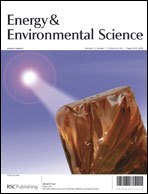A new composite cathode material made of La0.6Sr0.4Co0.2Fe0.8O3 − δ (LSCF), a mixed oxygen-ion/electron conductor, and BaZr0.5Pr0.3Y0.2O3 − δ (BZPY30), a mixed proton/electron conductor, is here developed for application in intermediate temperature solid oxide fuel cells (IT-SOFCs) based on proton conducting electrolytes. The wet chemical synthesis route allows sub-micrometre particle powders to be obtained, resulting in a highly porous microstructure. The developed composite cathode shows improved performance compared to the reported cathodes working in protonic SOFCs, achieving a total area specific resistance (ASR) in wet O2 of 0.011, 0.089, and 0.6 Ω cm2 at 700, 600, and 500 °C, respectively. Electrochemical impedance spectroscopy measurements indicate that several processes contribute to the overall cathode resistance. Performing area specific resistance measurements at different pO2 values allows the correlation of the various semicircles observed in the LSCF–BZPY30 impedance plots to different cathode reaction processes, i.e.water formation, oxygen surface dissociation, and diffusion. Fuel cell tests confirm the good performance of the LSCF–BZPY30 cathode for proton conducting oxide electrolytes.

You have access to this article
 Please wait while we load your content...
Something went wrong. Try again?
Please wait while we load your content...
Something went wrong. Try again?


 Please wait while we load your content...
Please wait while we load your content...